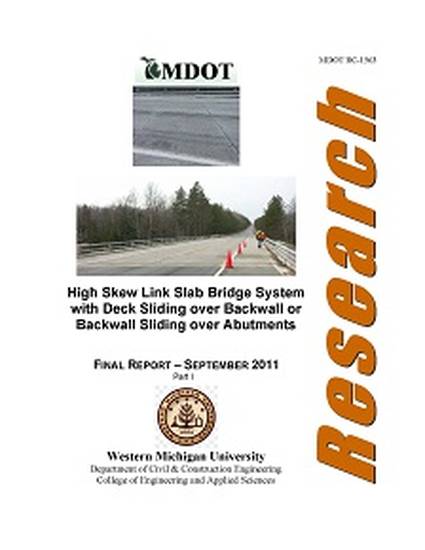
Article
High Skew Link Slab Bridge System with Deck Sliding over Backwall or Backwall Sliding over Abutments
Michigan Department of Transportation
(2011)
Abstract
A new bridge design and construction trend to help improve durability and rideability is to remove expansion joints over piers and abutments. One approach to achieve this is to make the deck continuous over the piers by means of a link slab while the girders remain simply supported. The need to implement link slabs is indicated by AASHTO LRFD section 2.5.2.4 which requires using a minimum number of expansion joints to improve rideability. Further, due to durability concerns associated with bridge deck joints, it is preferred to have a least number of joints or develop jointless decks. The expansion joints over the abutments can be removed by one of three methods: deck sliding over back wall, semi-integral abutments, and integral abutments. This results in expansion joints at either or both ends of the approaches. The design concerns other than link slab include backwall and wing-wall design and bearing movement. The behavior of a jointless bridge brings about many challenges to bridge designers. The complexity is augmented when skew is involved.
This report complements an earlier report based on previous research on <em>Combining Link Slab, Deck Sliding Over Backwall and Revising Bearings</em> (Aktan et al., 2008) where the behavior of straight and moderately skew ()skew < 20◦) jointless bridges with link slabs and two abutment configurations. these abutment configurations are deck sliding over backwall and backwall sliding over abutments (i.e. semi-integral abutments).
Four tasks were performed in this project. The first task was to review and synthesize information related to the behavior, performance, design, and analysis of skew bridges. The second task was field assessment of skew bridge behavior under static truck loads and thermal loads. The third task was analytical and numerical analysis of skew link slabs. The final task was analytical and numerical analysis of skew sliding deck over backwall systems and semi-integral abutments.
Design recommendations are developed based on literature, field assessment data analysis, finite element modeling, and subsequent simulations of the numerous models developed in this project. One recommendation deals with the skew link slab design and the remaining recommendations are for bearing selection and selection and design of a transverse restraint system at abutments of skew link slab bridges.
Disciplines
Publication Date
September 30, 2011
Citation Information
Haluk Aktan, Upul Attanayake and Steve Kahl. "High Skew Link Slab Bridge System with Deck Sliding over Backwall or Backwall Sliding over Abutments" Michigan Department of Transportation (2011) Available at: http://works.bepress.com/upul-attanayake/38/
